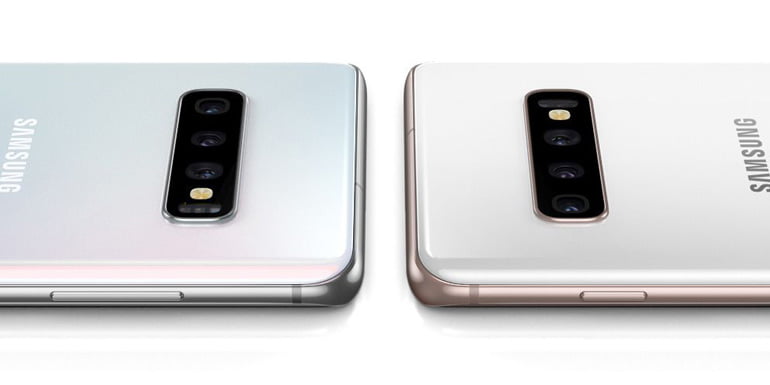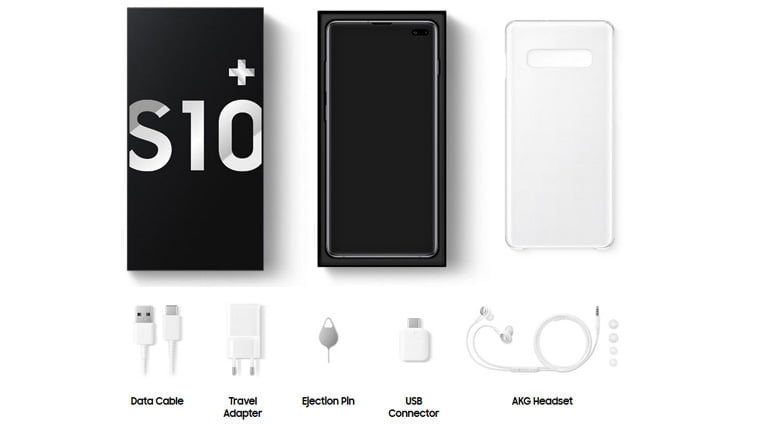Punching a hole right through the screen, thus doing away with the boring notches and cutouts, Samsung, the South Korean consumer electronics giant has unveiled its 2019 flagship android smartphone series. The mobile vendor has launched three models – the Samsung Galaxy S10, Galaxy S10+, Galaxy S10e – catering the needs of its premium customer base.
Overall, smartphones in the Samsung Galaxy S10 series share an extensive list of common hardware and design features. Most prominent among is the hole-punch in the display, which Samsung calls the Infinity-O Display panels. They’re small cutouts on the display for the front selfie cameras, thus avoiding the weird notches. All three smartphones have Dynamic AMOLED screen which is HDR10+ certified and delivers Dynamic Tone Mapping. The Dynamic AMOLED screen uses a unique fluid composite which reduces harmful blue light by 42 per cent.

Other common hardware in all three Galaxy S10 smartphones includes the Qualcomm Snapdragon 855 processor or the Exynos 9820 processor (Indian build), IP68-certified for dust and water resistance, Fast Wireless Charging 2.0 and reverse wireless charging. Let’s dig deep into the hardware part.
Infinity-O Display
Samsung Galaxy S10 series smartphones feature a cinema-grade display with its Dynamic AMOLED screen. It’s also the first HDR10+ certified display with a peak brightness of 1,200 nits. All three smartphones have a hole-punch cutout in the display for the front camera.
The Samsung Galaxy S10+ has the biggest screen size among the three flaunting 6.4-inch QHD+ curved Dynamic AMOLED Infinity-O Display. It keeps the 19:9 aspect ratio and packs a pixel density of 438ppi. The Samsung Galaxy S10 got a slightly smaller screen, 6.1-inch QHD+ Curved Dynamic AMOLED Infinity-O Display with a 19:9 aspect ratio and a 550ppi pixel density. The Samsung Galaxy S10e got a significant cut in the screen size, flaunting 5.8-inch full-HD+ Flat Dynamic AMOLED Infinity-O Display. Yet, the display has a high pixel density of 522ppi.

Talking about the build quality, all three smartphones in the Samsung Galaxy S10 series are built with glass on the front and back sandwiched with an aluminum frame in the middle. The Galaxy S10 and Galaxy S10+ front glass are protected with Gorilla Glass 6. While the rear glass on Galaxy S10, Galaxy S10+ and Galaxy S10e (both front and back glass) got protected with Gorilla Glass 5. If you’re looking for a much more stronger build quality, then there is a ceramic version available for Galaxy S10+ models. All three smartphones are also IP68 rated for water and dust resistance.
Power-Packed Performance
Samsung Galaxy S10, Galaxy S10+ and Galaxy S10e are powered by 7nm octa-core Qualcomm Snapdragon 855 SoC. However, in India and some other regions, the Snapdragon processor is swapped with Samsung’s own 8nm octa-core Samsung Exynos 9820 SoC.
Pairing with the processor, Samsung Galaxy S10 comes in either 8GB RAM and 128GB storage or 8GB RAM + 512GB storage options. Whereas, the Samsung Galaxy S10+ packs a punch with a 12GB of RAM and 1TB of storage option. You would also get to choose from 8GB RAM and 128GB storage or 8GB RAM + 512GB storage options. The Samsung Galaxy S10e comes in 6GB RAM and 128GB storage or 8GB RAM and 256GB storage options.
For all three Galaxy S10 series smartphones, you could expand the storage up to 512GB with microSD cards. They pack hybrid SIM tray which you could swap for either a second SIM or microSD card.
With PUBG and other graphics intense games on the rise, all three Galaxy S10 series smartphones come with advanced hardware and software optimization for gaming. In Samsung Galaxy S10+, you get Vapor chamber cooling system, whereas in Galaxy S10 and Galaxy S10e you have an advanced heat pipe cooling system. With AI-based performance improvements, and an optimized GPU you could except smooth gameplay. There is also a Dolby enhanced game mode, which delivers a realistic picture and better sound.
For audiophiles, the Samsung Galaxy S10 series smartphones offer Dolby Atmos enhanced sound with stereo speakers tuned by AKG.
Multi-Camera
Samsung is touting its Galaxy S10 series smartphones to have cameras that let you shoot like a pro without being a pro. On Samsung Galaxy S10+ and Galaxy S10, you get a triple-lens camera system on the rear. This includes a Telephoto camera for that extra zoom, a Wide-angle camera with Dual Aperture which supports F1.5 mode and F2.4 mode, and an Ultra Wide Camera for panoramic landscapes.
The rear camera setup in Galaxy S10+ and Galaxy S10 consists of a 12-megapixel wide-angle camera with a 77-degree field of view, 2PD autofocus, a variable aperture ranging from F1.5 to F2.4 mode, and OIS. The second unit is a 12-megapixel 45-degree lens telephoto camera with autofocus, an f/2.4 aperture, OIS and support for 0.5x and 2x optical zoom. Finally, there is the 16-megapixel Ultra Wide camera with a 123-degree field of view, fixed focus, 10x digital zoom and an f/2.2 aperture.

While in Samsung Galaxy S10e, there is a dual rear camera. It’s a combination of a 12-megapixel wide-angle camera with 77-degree lens, 2PD autofocus, a variable aperture of f/1.5 to f/2.4, and OIS. The second unit is a 16-megapixel Ultra Wide camera with a 123-degree field of view, fixed focus, 10x digital zoom and an f/2.2 aperture. You also get a 0.5x optical zoom, and up to 8x digital zoom with this camera setup.
For selfies, the Samsung Galaxy S10+ packs a dual hole-punch or dual front cameras. The primary front camera is a 10-megapixel sensor with an 80-degree lens, 2PD autofocus and an f/1.9 aperture. It’s coupled with the second camera of an 8-megapixel fixed focus RGB depth sensor featuring f/2.2 aperture and a 90-degree field-of-view.
On Samsung Galaxy S10 and Galaxy S10e, there is a single front selfie camera which is the same 10-megapixel unit in Galaxy S10+.
Talking about camera functionalities, with Scene Optimizer the photo assistant can recognize 30 popular subjects and automatically adjusts your camera settings to the scene. There is a Bright Night mode, which vastly improves low-light photography, just like the night mode in the latest Pixel smartphones.
For taking videos, all three Galaxy S10 series smartphones comes with support for 4K UHD and HDR10+ recording. On Samsung Galaxy S10+ you could record videos in 4K UHD with the front-facing cameras. You could also record Super Slow-mo videos in HD quality at 960 frames per second.
Next generation connectivity
All three Samsung Galaxy S10 series smartphones come with faster and intelligent Wi-Fi and LTE connectivity options. You get 4G VoLTE (LTE Cat. 20), 3G and 2G network options along with Wi-Fi 802.11ax, Bluetooth 5.0 and a USB Type-C port. Samsung has also kept the 3.5mm headphone jack intact. These smartphones also pack a bunch of sensor like Accelerometer, Barometer, Gyro Sensor, Compass, Magnet (Hall) Sensor, Proximity Sensor, RGB Light Sensor and HR Sensor.
Samsung Galaxy S10 and Galaxy S10+ feature Ultrasonic in-display fingerprint scanner, while the Galaxy S10e has a capacitive fingerprint sensor on the side home button. The company also packs its multi-layered security feature, the Samsung Knox, which is built right into the phone’s hardware and software. There would also be the Samsung Pay integration for easy payments from your mobile.
Finally coming to the battery pack, the Samsung Galaxy S10+ runs on a 4,100mAh battery, while the Galaxy S10 is powered by a 3,400mAh battery and the Galaxy S10 get a moderate 3,100mAh battery unit. With its AI implementation, the phone learns your daily routine and usage patterns, powering down apps you don’t need. With Adaptive Power Saving mode, the battery life is managed based on the prediction of your daily usage.

All three Samsung Galaxy S10 series smartphones support Fast Wireless Charging 2.0 along with Wireless PowerShare. Thus you could use the phone to charge other Qi-certified devices and like a wireless charger. For normal wired charging these smartphones supports Quick Charge 2.0 and Adaptive Fast Charging.
Big Pricing
To the last part, the Samsung Galaxy S10 price starts at 66,900 INR. For colour options, you could choose from Prism Black, Prism Blue, Prism Green, and Prism White variants. The more costly Samsung Galaxy S10+ price starts at 73,900 INR. It’s available in Prism Black, Prism Blue, Prism Green, and Prism White colour variants along with Ceramic Black and Ceramic White exclusive colour options.
Finally the more budget-friendly among the three, the Samsung Galaxy S10e starts at a price tag of 55,900 INR. It’s available in Prism Black, Prism Blue, Prism Green, Prism White and Canary Yellow colour options.
All three Samsung Galaxy S10 series phones will be available via Flipkart, Amazon India, TataCliQ, Paytm Mall and Samsung India e-Store.


